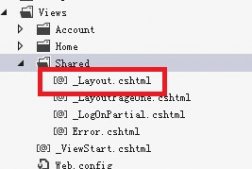ASP.NET终于可以跨平台了,但是不是我们常用的ASP.NET, 而是叫一个ASP.NET Core的新平台,他可以跨Windows, Linux, OS X等平台来部署你的web应用程序,你可以理解为,这个框架就是ASP.NET的下一个版本,相对于传统ASP.NET程序,它还是有一些不同的地方的,比如很多类库在这两个平台之间是不通用的。
今天首先我们在ASP.NET Core中来实现一个基础的身份认证,既登陆功能。
前期准备:
1.推荐使用 VS 2015 Update3 作为你的IDE
2.你需要安装.NET Core的运行环境以及开发工具
创建项目:
在VS中新建项目,项目类型选择ASP.NET Core Web Application (.NET Core), 输入项目名称为TestBasicAuthor。

接下来选择 Web Application, 右侧身份认证选择:No Authentication

打开Startup.cs
在ConfigureServices方法中加入如下代码:
|
1
|
services.AddAuthorization(); |
在Configure方法中加入如下代码:
|
1
2
3
4
5
6
7
8
|
app.UseCookieAuthentication(new CookieAuthenticationOptions { AuthenticationScheme = "Cookie", LoginPath = new PathString("/Account/Login"), AccessDeniedPath = new PathString("/Account/Forbidden"), AutomaticAuthenticate = true, AutomaticChallenge = true}); |
完整的代码应该是这样:
|
1
2
3
4
5
6
7
8
9
10
11
12
13
14
15
16
17
18
19
20
21
22
23
24
25
|
public void ConfigureServices(IServiceCollection services) { services.AddMvc(); services.AddAuthorization(); } public void Configure(IApplicationBuilder app, IHostingEnvironment env, ILoggerFactory loggerFactory) { app.UseCookieAuthentication(new CookieAuthenticationOptions { AuthenticationScheme = "Cookie", LoginPath = new PathString("/Account/Login"), AccessDeniedPath = new PathString("/Account/Forbidden"), AutomaticAuthenticate = true, AutomaticChallenge = true }); app.UseMvc(routes => { routes.MapRoute( name: "default", template: "{controller=Home}/{action=Index}/{id?}"); }); } |
你或许会发现贴进去的代码是报错的,这是因为还没有引入对应的包,进入报错的这一行,点击灯泡,加载对应的包就可以了。

在项目下创建一个文件夹命名为Model,并向里面添加一个类User.cs
代码应该是这样
|
1
2
3
4
5
|
public class User{ public string UserName { get; set; } public string Password { get; set; }} |
创建一个控制器,取名为:AccountController.cs
在类中贴入如下代码:
|
1
2
3
4
5
6
7
8
9
10
11
12
13
14
15
16
17
18
19
20
21
22
23
24
25
26
27
28
29
30
31
32
33
34
35
36
37
38
39
40
41
42
43
44
45
46
47
48
|
[HttpGet] public IActionResult Login() { return View(); } [HttpPost] public async Task<IActionResult> Login(User userFromFore) { var userFromStorage = TestUserStorage.UserList .FirstOrDefault(m => m.UserName == userFromFore.UserName && m.Password == userFromFore.Password); if (userFromStorage != null) { //you can add all of ClaimTypes in this collection var claims = new List<Claim>() { new Claim(ClaimTypes.Name,userFromStorage.UserName) //,new Claim(ClaimTypes.Email,"emailaccount@microsoft.com") }; //init the identity instances var userPrincipal = new ClaimsPrincipal(new ClaimsIdentity(claims, "SuperSecureLogin")); //signin await HttpContext.Authentication.SignInAsync("Cookie", userPrincipal, new AuthenticationProperties { ExpiresUtc = DateTime.UtcNow.AddMinutes(20), IsPersistent = false, AllowRefresh = false }); return RedirectToAction("Index", "Home"); } else { ViewBag.ErrMsg = "UserName or Password is invalid"; return View(); } } public async Task<IActionResult> Logout() { await HttpContext.Authentication.SignOutAsync("Cookie"); return RedirectToAction("Index", "Home"); } |
相同的文件里让我们来添加一个模拟用户存储的类
|
1
2
3
4
5
6
7
|
//for simple, I'm not using the database to store the user data, just using a static class to replace it.public static class TestUserStorage{ public static List<User> UserList { get; set; } = new List<User>() { new User { UserName = "User1",Password = "112233"} };} |
接下来修复好各种引用错误。
完整的代码应该是这样
|
1
2
3
4
5
6
7
8
9
10
11
12
13
14
15
16
17
18
19
20
21
22
23
24
25
26
27
28
29
30
31
32
33
34
35
36
37
38
39
40
41
42
43
44
45
46
47
48
49
50
51
52
53
54
55
56
57
58
59
60
61
62
63
64
65
66
67
68
69
70
71
72
73
|
using System;using System.Collections.Generic;using System.Linq;using System.Threading.Tasks;using Microsoft.AspNetCore.Mvc;using TestBasicAuthor.Model;using System.Security.Claims;using Microsoft.AspNetCore.Http.Authentication;// For more information on enabling MVC for empty projects, visit http://go.microsoft.com/fwlink/?LinkID=397860namespace TestBasicAuthor.Controllers{ public class AccountController : Controller { [HttpGet] public IActionResult Login() { return View(); } [HttpPost] public async Task<IActionResult> Login(User userFromFore) { var userFromStorage = TestUserStorage.UserList .FirstOrDefault(m => m.UserName == userFromFore.UserName && m.Password == userFromFore.Password); if (userFromStorage != null) { //you can add all of ClaimTypes in this collection var claims = new List<Claim>() { new Claim(ClaimTypes.Name,userFromStorage.UserName) //,new Claim(ClaimTypes.Email,"emailaccount@microsoft.com") }; //init the identity instances var userPrincipal = new ClaimsPrincipal(new ClaimsIdentity(claims, "SuperSecureLogin")); //signin await HttpContext.Authentication.SignInAsync("Cookie", userPrincipal, new AuthenticationProperties { ExpiresUtc = DateTime.UtcNow.AddMinutes(20), IsPersistent = false, AllowRefresh = false }); return RedirectToAction("Index", "Home"); } else { ViewBag.ErrMsg = "UserName or Password is invalid"; return View(); } } public async Task<IActionResult> Logout() { await HttpContext.Authentication.SignOutAsync("Cookie"); return RedirectToAction("Index", "Home"); } } //for simple, I'm not using the database to store the user data, just using a static class to replace it. public static class TestUserStorage { public static List<User> UserList { get; set; } = new List<User>() { new User { UserName = "User1",Password = "112233"} }; }} |
在Views文件夹中创建一个Account文件夹,在Account文件夹中创建一个名位index.cshtml的View文件。
贴入如下代码:
|
1
2
3
4
5
6
7
8
9
10
11
12
13
14
15
16
17
18
19
20
21
22
23
24
25
26
27
28
29
30
|
@model TestBasicAuthor.Model.User<html xmlns="http://www.w3.org/1999/xhtml"><head> <title></title></head><body> @using (Html.BeginForm()) { <table> <tr> <td></td> <td>@ViewBag.ErrMsg</td> </tr> <tr> <td>UserName</td> <td>@Html.TextBoxFor(m => m.UserName)</td> </tr> <tr> <td>Password</td> <td>@Html.PasswordFor(m => m.Password)</td> </tr> <tr> <td></td> <td><button>Login</button></td> </tr> </table> }</body></html> |
打开HomeController.cs
添加一个Action, AuthPage.
|
1
2
3
4
5
6
|
[Authorize][HttpGet]public IActionResult AuthPage(){ return View();} |
在Views/Home下添加一个视图,名为AuthPage.cshtml
|
1
2
3
4
5
6
7
8
9
10
|
<html xmlns="http://www.w3.org/1999/xhtml"><head> <title></title></head><body> <h1>Auth page</h1> <p>if you are not authorized, you can't visit this page.</p></body></html> |
到此,一个基础的身份认证就完成了,核心登陆方法如下:
|
1
2
3
4
5
6
|
await HttpContext.Authentication.SignInAsync("Cookie", userPrincipal, new AuthenticationProperties{ ExpiresUtc = DateTime.UtcNow.AddMinutes(20), IsPersistent = false, AllowRefresh = false}); |
启用验证如下:
|
1
2
3
4
5
6
7
8
9
10
11
|
public void Configure(IApplicationBuilder app, IHostingEnvironment env, ILoggerFactory loggerFactory){ app.UseCookieAuthentication(new CookieAuthenticationOptions { AuthenticationScheme = "Cookie", LoginPath = new PathString("/Account/Login"), AccessDeniedPath = new PathString("/Account/Forbidden"), AutomaticAuthenticate = true, AutomaticChallenge = true });} |
在某个Controller或Action添加[Author],即可配置位需要登陆验证的页面。
以上就是本文的全部内容,希望对大家的学习有所帮助,也希望大家多多支持服务器之家。
原文链接:http://www.cnblogs.com/onecodeonescript/p/6015512.html












